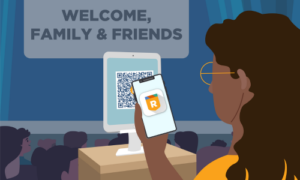Listen to this blog (8 mins)
It’s important to know precisely who you are welcoming into your schools. You can accomplish this with a school visitor management system that screens a visitor’s information against sex offender registries and customized, locally-owned lists, like those containing individuals with custodial restrictions.
Best practice is to scan the visitor’s government-issued ID to verify their identity and screen their information against the databases. But what happens when a visitor doesn’t have an ID, refuses to share their personal information with you, or is a confirmed sex offender? When and how do you deny someone access?
These are just some of the issues school staff must be prepared to address.
Continue reading for recommendations on how to handle some of the most common scenarios related to K-12 visitor management practices. This guidance is based on Raptor’s experience partnering with over 35,000 K-12 schools across the country.
1- Screening Undocumented Persons or Those Without IDs
If the visitor does not have an ID, front desk staff can manually enter the visitor’s information into the system so they can be screened; however, this gives the visitor the chance to falsify their information. Especially when the individual is unknown to school staff, the front desk employee should notify the principal or another administrator so they can determine if the visitor needs to be supervised during their visit.
It’s also best practice to ask these individuals to bring at least one document that verifies their identity the next time they come to campus. This document should provide their full name and date of birth and be used to confirm the validity of the information they provided at their initial visit.
2- Handling Visitors who Refuse to Provide Their Information
This reluctancy is typically based on privacy concerns, anxiety related to undocumented persons, or issues with the visitor being a registered sex offender. The front desk employee should notify the school resource officer (SRO) or principal so they can greet the individual and determine if they receive access and/or require supervision.
Districts should regularly share information about their visitor management system and policies with the school community to help combat these issues. This communication can include posting signs on your entry doors and sending letters home with students.
3- Responding to a New Sex Offender or Custom Alert Match
If your front desk employee confirms that the visitor matches a sex offender or custom alert, the system should automatically notify the appropriate personnel for assistance. While those personnel come to the front office, the front desk employee should inform the visitor that there is an issue with the system, and they cannot complete the process. If the individual refuses to wait, the school should return their ID and allow the individual to leave. Your visitor management system will keep track of their information and alert you, and other appropriate personnel, if they attempt to sign in at another time, even if the next time is at another building in your district.
As some visitors may become angry at the news that they are a confirmed match and/or are denied access, it’s important to have an emergency management system with a mobile panic button that allows authorized users to quickly summon help for any situation. The panic button solution should also allow the user to connect directly with 911 if police response is necessary.
4- Determining When and Whether to Allow Known Offenders
You may have instances where a legal guardian/parent is a registered sex offender or has restricted access to their child(ren). In this case, many schools alert the appropriate personnel to escort the guardian/parent during their visit. They also may have limited access to the campus, such as restricted time or destinations.
A similar process can be followed for contractors or vendors who are confirmed sex offenders; however, it is highly recommended that the school does not allow the vendor or contractor into its buildings. Instead, the school should contact the vendor or contractor’s manager and require them to send another individual.
“[We flagged] two [who] were contractors, one of whom was a registered sex offender who had been working in our buildings for seven years. We also flagged the spouse of a staff member who had not previously been reported to us as a sex offender. As I said, [Raptor Visitor Management has] dramatically improved our level of security.”
– Spring Charter Schools, CA
5- Screening Visitors for COVID-19 and Facilitating Contact Tracing
Schools should screen visitors, guardians, volunteers, and contractors for COVID-19 exposure risk before giving them access to the building. You can do this by adding a set of COVID-19-specific questions to your visitor check-in procedures. Schools should also consider implementing kiosks for contactless sign-in. Your visitor management system will automatically track every individual who enters the building. This will give you instant access to the information needed to effectively and promptly contact trace should a person who visited the school subsequently test positive.
Because visitor management systems can help with COVID-19 mitigation, many schools have decided to implement systems during the pandemic. Schools also can leverage the various COVID-19 relief funds to purchase visitor—as well as emergency and volunteer management—systems to safely reopen and stay open.
6- Accounting for Visitors During an Emergency
If your school needs to evacuate on a moment’s notice and you need to account for everyone in your buildings, you must have accurate visitor records. The most powerful systems integrate with an emergency management system that streamlines the accountability process so you can respond to and recover from emergencies faster. This integration enables you to account for every visitor (including contractors, volunteers, vendors, substitutes, guardians, etc.) who is signed into the visitor management system.
“We’re doing renovations and building new campuses, so we have a lot of contractors in and out of our campuses every day. Raptor Visitor Management is integral in keeping track of who is on each campus, and because it integrates with Raptor Emergency Management, we’re able to track and account for those contractors if we need to evacuate.”
– Bay City Independent School District, TX
Confidently Respond to These Issues
Every school needs a visitor management policy that describes what their procedure will be for anyone entering the buildings. Coupled with a powerful visitor management system, this policy is your first line of defense against unwanted entrants.
It’s important that you follow the latest recommendations and best practices to keep your schools safe. Partnering with an industry leader can make all the difference. With nearly 20 years of experience and partnerships with industry experts and over 35,000 K-12 schools, Raptor keeps updated on the latest best practices and happily shares our research and recommendations to help schools evolve as safety needs change.
Contact us today to see how Raptor Visitor Management works and how our experts can help you build and maintain a safe school.





